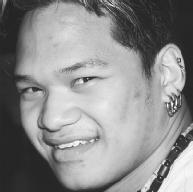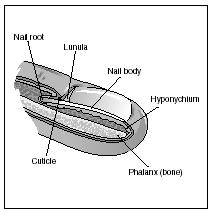Like hair, nails are formed by keratin. Tiny cells living at the base and side of the nail manufacture the keratin that produces nails. The cuticle (the skin surrounding the nail) protects these cells.
Keeping Nails Clean and Neat
Nails should always be kept clean and neatly trimmed or filed. Dirt and bacteria can get trapped in nails that aren't clean. As with the hands, nails are a way for bacteria to be passed from person to person. Preventing the spread of bacteria prevents the spread of illness and infection. Nails that are excessively long can, by virtue of their length, hold more dirt than shorter nails. Those with longer nails, then, need to be more diligent about keeping their nails clean. Hangnails (loose skin near the base of the nail) should be carefully trimmed with a cuticle clipper and the area kept clean to prevent infections.

EAR PIERCING
Ear piercing is a common practice among girls, and many people consider it a rite of passage. Even boys may pierce one or both of their ears at some point in their lives. Choosing to pierce one's ears is a personal decision, however, and some people decide it's not for them. If ear piercing is done, it's very important to have it done by a professional.
Some people try to pierce their own ears. Doctors do not recommend this because, without proper sterilization, a person risks injury and infection. Ear piercing professionals use an instrument called the autoclave, which completely sterilizes equipment used in the procedure. Home methods and home ear-piercing kits do not allow a person to properly sterilize the needle used to pierce the ear. An infection can cause the ear to swell and, in more serious cases, scar the earlobe.
When ears are pierced professionally, there are aftercare instructions available that help prevent infection. These instructions usually include cleaning the lobes with alcohol or mild soap two times each day. After the ears are pierced, it usually takes a full six weeks for them to heal. Don't try to change earrings before the ears have properly healed. Patience is just as important as good hygiene. Finally, when the ears are healed, always clean new earrings with alcohol before inserting them. Also, it's not smart to share earrings without cleaning them first.
People who are allergic to certain types of metals or prone to infection should think carefully or consult with a doctor before getting their ears pierced.
Manicures and pedicures (for the toenails) can help keep nails clean and well-shaped. However, when getting a manicure or a pedicure it is helpful to have a personal kit of implements (nail file, buffer, etc.) as bacteria can easily be passed from person to person when instruments are used on different people and aren't properly sterilized (to free something from living bacteria). In fact, most nail salons now insist that customers purchase their own "kit," which the manicurist can then use on the client. Even when tending to one's own nails, instruments should be carefully washed and sterilized with alcohol to prevent the growth of bacteria on any of the tools used in manicures or pedicures.
What Nails Can Tell a Doctor
Keeping one's nails healthy and clean is important as doctors and other healthcare professionals can often tell a lot about a patient when looking at the nails. Disorders ranging from cancer to kidney disease to malnutrition can often be detected by looking at a person's nails.
INGROWN TOENAIL. Toenails become ingrown when the edges of the nail grow into the surrounding skin. This occurs when a nail that is deformed grows improperly into the skin, or when the skin around the nail grows rapidly and covers part of the nail. Symptoms include redness and pain around the area. If the toenail becomes infected, the area will swell and blisters can develop. In mild cases, the ingrown toenail can be remedied with a simple trimming; however, many times medical attention is required. Wearing shoes that fit properly can prevent ingrown toenails. Also, it is important not to trim toenails too short.
PARONYCHIA. Paronychia, an infection around the edge of a fingernail or toenail, often begins from a break in the skin due to a hangnail, vigorous manicuring, or chronic irritation (from rubbing or picking). An infection of this type can be very painful as the nail area will swell (and because it's a small area, there isn't much room to swell). Bacteria or fungi can cause paronychia. Hot compresses can help relieve pain and may help drain any pus that has accumulated. Tending to hangnails, being careful and gentle when manicuring nails, and avoiding picking or rubbing the area around the nails may prevent paronychia.
CUTICLES: TO TRIM OR NOT TO TRIM
Not too long ago, if you went into a salon for a manicure or pedicure, the manicurist would push back your cuticles and cut away the excess skin. This would be done to allow for a smoother surface on which to polish the nails. Now, manicurists ask clients whether or not they wish to cut their cuticles. And there's an important reason why. The cuticle protects the integrity of the nail by "guarding" the cells that manufacture keratin, which forms the nail. If a cuticle is trimmed and becomes infected or if a cuticle is trimmed to expose a sensitive area of the nail, future growth of that nail could be compromised. Many doctors and manicurists now advise their clients not to cut their cuticles at all.
ONYCHOMYCOSIS. This fungal infection of the nails can be contracted by walking barefoot in public places or in conjunction with the development of athlete's foot. Antifungal drugs are

used to treat this disorder. Keeping nails short can help minimize discomfort. Preventative measures against onychomycosis include covering the feet when walking outside the home.
NAIL RINGWORM. With nail ringworm, a fungal infection, similar to athlete's foot, infects the newest formed part of the nail. This causes the nail to grow in thick and deformed. This is treated with antifungal drugs. Keeping hands clean, particularly after being in public places such as gyms, may help prevent the transmission of nail ringworm. Also, the use of personal manicure implements can help prevent nail ringworm.


